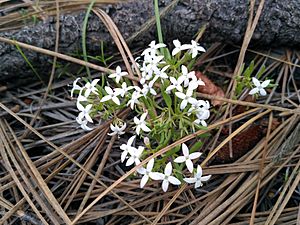Pygmy bluet facts for kids
Quick facts for kids Pygmy bluet |
|
|---|---|
 |
|
| Scientific classification | |
| Synonyms | |
|
The pygmy bluet (Houstonia wrightii) is a tiny flowering plant. It belongs to the Rubiaceae family, which is a large group of plants that includes the coffee plant! This small plant is native to the southwestern United States and northern Mexico. It was first described in 1882.
Contents
Discovering the Pygmy Bluet
The pygmy bluet gets its name because it is very small. "Pygmy" means tiny, and "bluet" refers to its often pale blue or white flowers. It's a delicate plant that can be easy to miss if you're not looking closely.
Where the Pygmy Bluet Lives
This plant loves dry, open spaces. You can find it growing in rocky areas, grasslands, and even along roadsides. It prefers places with lots of sunlight.
It grows naturally in several states in the United States. These include Arizona, New Mexico, and the western part of Texas. South of the border, it is found in northern Mexico. Here, it grows in states like Chihuahua, Sonora, and Hidalgo.
What the Pygmy Bluet Looks Like
The pygmy bluet is a very small plant. It usually grows only a few inches tall. Its stems are thin and often branch out. The leaves are tiny and narrow.
Its flowers are also very small. They typically have four petals. These petals can be white, light blue, or sometimes a pale lavender color. The flowers often appear in clusters at the top of the stems. They add a touch of color to the dry landscapes where the plant lives.
Life Cycle of the Pygmy Bluet
Like many plants, the pygmy bluet starts its life as a seed. When the conditions are right, the seed sprouts. It grows into a small plant. The plant then produces its tiny flowers. These flowers are important for reproduction.
After the flowers are pollinated, they produce small fruits. These fruits contain new seeds. The seeds are then dispersed, often by wind or animals. This allows new pygmy bluet plants to grow in other areas. The plant usually flowers in the spring and early summer.
Why the Pygmy Bluet is Special
Even though it's small, the pygmy bluet is an important part of its ecosystem. It provides food and habitat for tiny insects. It also helps to prevent soil erosion in the dry areas where it grows. Its ability to thrive in harsh, dry conditions makes it a resilient plant. It shows how life can adapt to many different environments.

